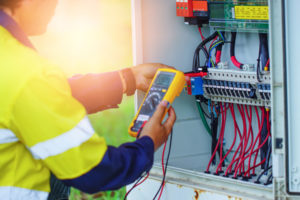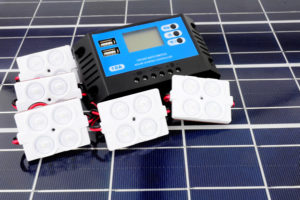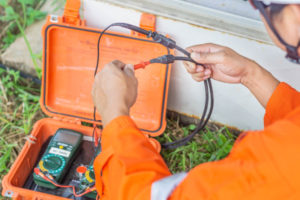With solar energy becoming increasingly popular, it’s important to know how to test solar panel amps. This blog will teach you step-by-step how to measure solar panel power output with a multimeter, watt meter, and solar charge controller. By understanding the amp reading of your solar panel, you can troubleshoot issues and get the most out of your system. Have fun testing out your solar panel amp knowledge and let us know how you go in the comments below!

1. How to Test a Solar Panel with a Multimeter
Testing solar panel amperage is essential to ensure your system is receiving the power it needs. To do this, you’ll need to measure the amperage, voltage, and watt hours. There are a few things you’ll need for this test: a multimeter, solar panel, battery, and power outlet. To test the amperage, measure how long it takes for your battery to discharge when connected to the solar panel. To measure voltage, connect one end of a multimeter to each lead on the solar panel and the other end to an appropriate power outlet. To measure watt hours, use something like a Joule Thief or Kill A Watt meter and record how many watts of energy is drawn from the wall socket over a period of time (usually 10-15 minutes).
What You Need
Before you can begin testing solar panels, you will need to understand how they work. This is where a multimeter comes in handy as it allows for accurate measurements. To measure the output of a solar panel, connect it to the multimeter and turn it on. Then slowly increase the voltage until the panel starts generating current. Once this happens, record the current output by writing it down on a piece of paper or an electronic device such as a laptop or smartphone. Make sure your solar panel is correctly connected before measuring its current output.
You must be aware of the solar panel’s open circuit voltage in order to evaluate its performance (Voc). A multimeter or an ohmmeter can be used to measure this voltage, which is what the solar panel reads when it is not connected to the power source.

Step 2: Measure Short Circuit Current (Isc)
Testing solar panel amps is an important step in ensuring that they are functioning correctly. By checking the amp output of the solar panel, you can identify any issues and correct them before they cause bigger problems. Short circuit current (Isc) is a measure of how well a solar panel is working and can be used to pinpoint areas where there might be faults with installation or wiring. A multimeter makes testing solar panels quick and easy, helping technicians work more efficiently without having to struggle with complicated electrical equipment.
Step 3: Measure Operating Current (aka PV Current)
To measure the operating current of your solar panel, first determine the voltage across it using a voltmeter and then divide by the amp rating of your meter. This will give you the operating current in amps. Next, use your multimeter to measure the output voltage of your solar panel when it is connected to a load (aka PV Voltage). Finally, use Ohm’s Law to calculate how much power is being produced by the solar panel (PV watts).

Connect the Battery to the Charge Controller
Testing your solar panel is an important step in getting the most out of it. The first step is to connect the battery to the charge controller. Make sure you have done this correctly and that all connections are secure. Next, test your solar panel by connecting it to the load (or power needs) of your chosen device or system. Finally, check all connections are secure and there are no shorts between devices or cables
Connect the Solar Panel to the Charge Controller
In order to power your system with solar energy, it is important to connect the solar panel to the charge controller. Make sure that voltage and current are correct before connecting the cables. Once everything is set up correctly, you can begin powering your system! Make sure you read the manufacturer’s instructions first – they will guide you step-by-step through connecting the solar panel and charge controller. Happy powering!
Calculate Power Output
Testing solar panels is an important step in ensuring they are working properly. To do this, you’ll need to know the wattage and amp rating of the panel in question. Once you have found the panel, attach the multimeter to one of its terminals and start measuring voltage output (between 10-12VDC). Compare this value with your solar panel’s wattage – it should be between 1W and 20W. If there is a discrepancy between these two values, it means that your solar panel might not be functioning properly and needs repair or replacement.
What You Need
It is essential to know how to use a multimeter in order to test solar panel amps. Checking voltage and amperage readings is the first step in troubleshooting any issues you might be having with your solar panels. Make sure you read the instruction manual carefully before testing your panels – this will give you specific instructions on how to use the multimeter.
You need to test the voltage of panel as it is very important parameter in timing and they are critical while testing dc voltage output of solar panels. When we measure dc voltage, which is not enough when you want to measure with a lower input current like 5 mA (0.05 A) or 0-5V range that’s needed for most indicator circuits uses just two electrodes instead three different terminals: positive (+), negative (-), and ground(GND).
The specifications label on the solar panels will provide specifications of voltage and current under tested conditions to determine whether it works or not, if there are more specifications then one will be able to comment on this matter as well.
This technique is used to test direct sunlight efficiency of a solar panel. If the direct sunlight LED does not light up your multimeter, you will have to determine the direct sunlight voltage (DCV) by other means such as photovoltaic module’s datasheet or getting it from an outdoor shop if there is one nearby. To calculate DCV, place your solar panel in direct sunlight and orientate its long side toward sun rays while placing short side on angle of about 45 degrees. Then measure voltage across the multimeter’s black probe with the red probe placed on solar panel-short side of module facing away from sun and open circuit voltage should be measured with multimeter set to ohm’s law (V=IR).
Mounting Method: whichever way is more convenient for you, there are two methods that can be used when mounting solar panels on roofs or walls. The first is to drill few holes and mount solar panel through them using screws while the second is where existing roof or wall penetrations are allen head bolts, use nuts and bolts to fasten solar panel to the roof or wall.
When testing a solar panel amperage, multimeter should be set in ohm’s law and dc voltage should also be measured across the multimeter probes. If voltage is lower then current requirement of circuit being tested, the solar panel is not working and will need to be replaced.
Connect Battery to Solar Charge Controller
In order to test solar panel amps, you first need to connect the battery to the solar charge controller. Make sure the solar panel is correctly connected and that the voltage is correct. Once everything is connected, turn on the charge controller and measure the output voltage from the solar panel. Compare this value with what your meter says and determine if there is a discrepancy in ampacity between Solar Panel and Charge Controller There are multiple factors that can affect wattage output from a photovoltaic (PV) system such as weather conditions, shading effects etc., so it’s important to have accurate measurements at all times in order for accurate analysis of your PV system performance or troubleshooting when needed!
Connect the Watt Meter to the Adapter Cables
In order to test solar panel amps, you will need the following: – Solar panel – N adapter cable – Watt meter 1. Connect the adapter cable to the watt meter and then connect it to the solar panel. 2. Once these are connected, turn on the watt meter and wait for it to reach a stable reading. 3. The higher the reading, the more amp is being output from the solar panel
Connect the Solar Panel
Solar panel amp output is the voltage generated by a solar panel when it is connected to an amp meter. This voltage can be measured using a multimeter and will give you an indication of how much power your solar panel is generating. To measure solar panel amp output, first make sure that both the multimeter and the solar panel are properly connected. Next, connect the red lead from the multimeter to one terminal on your solar panels positive cable (or inverter). Make sure that alligator clips are secure in order for accurate reading. Finally, turn on your multimeter and begin testing with Solar Panel Amp Output set at 0V DC or 5V DC according to your preference.
Measure Power Output

Testing solar power is important to ensure that the energy your panels are generating is actually turned into usable electricity. There are a few things you’ll need to do before measuring power output, including choosing the correct multimeter and cable, and converting voltage measurements to amp measurements. Once you’ve got all of this sorted out, it’s time to take readings from your solar panel. Note down the results so you can investigate any potential issues with your system later on. By doing this, you will be able to solve any problems quickly and continue generating clean energy without having to worry about it affecting your home or business in any way!
24V vs 48V Solar Systems
When it comes to solar systems, voltage is important. This is because solar panels work best when the voltage across them is high enough for the energy they convert to electricity to be maximized. Therefore, if you have a 24V system, you will need to use a multimeter to test the amperage. In order for your system to operate at its full potential and generate maximum power output, make sure that the multimeter registers an output of 24 volts or more. If it doesn’t meet this criteria, there may be an issue with your system and you’ll need assistance from a specialist in order fix it. If you happen to own a 48V solar system (which uses two multimeters – one for testing voltage and another for current), make sure both instruments are set up correctly before starting any tests – otherwise results could potentially be inaccurate. The Multimeter will indicate whether or not there’s an issue with your system- either too much current or too little voltage
200 Amp Solar System
To test a solar panel, it is important to first identify the terminals – black and red – where power is being drawn from. Next, connect the black lead to one of the terminal and the red lead to another terminal. If all goes well, you should now see a reading of around 200 amps on your multimeter. If not, check that both leads are properly connected and that there is no obstruction between them
12V Solar System
If your solar panel is not working, first check if it is getting the right amount of sunlight. Make sure the sun’s rays are reaching the solar panel properly. Next, test the solar panel’s electrical connection by measuring AC volts and DC volts. If both tests come back positive, then your solar power system probably needs a new fuse or circuit breaker; otherwise, there may be something wrong with your inverter or controller. Finally, test the amperage by measuring how much current is flowing through it (AC voltage × current = wattage). You should see around 10-12 watts output per amp when everything is working correctly
What Is the Maximum System Voltage in a Solar Panel?
To test a solar panel’s capacity, you need to measure its maximum system voltage. This is usually expressed in volts and can be found on the label of the solar panel or manufacturer website.
Adding Solar Panels to Existing System
There are a few things you should know before adding solar panels to your current system. First of all, if you have an existing solar system, you can simply add more panels to increase wattage. You can also test the amps of each individual panel to see if they are working properly. When it comes to installing the solar panels, make sure that you label the wires on each panel so that reconnecting them is easy once testing is complete. Finally, remember to double-check all connections before starting your solar system – this could save you a lot of money in the long run!
How to Measure Solar Panel Power Output with a Solar Charge Controller
Knowing how much power your solar panel is generating is important for a few reasons. For one, it’ll help you maintain its efficiency. Secondly, checking the power output can help you determine the amount of power your solar charge controller is limiting. This is important, as you don’t want to overcharge your solar panel and damage it. Testing is easy – all you need is a multimeter. Make sure to read the instructions that come with your charge controller before testing, so you know what to expect. Finally, solar panel power output is an important part of ensuring long-term savings on your energy bills.
How to Measure Solar Panel Output with a Watt Meter
Testing solar panel amps is an important step in maintaining your system. By checking the output of your panels, you can ensure they’re operating at their peak performance. Additionally, knowing the voltage and amp requirements of your system will help you avoid damaging anything. To test your solar panel amps, use a watt meter. Make sure to calibrate your watt meter regularly to ensure accurate readings.
Frequently Asked Questions
What is a solar panel ammeter and how can it be used to test solar panels?
A solar panel ammeter is a device that measures the output power of solar panels. This is helpful for determining if a solar panel is producing the correct voltage and current, which can help to optimize system performance. The ammeter will also show you how much power an individual or group of solar panels are able to generate. By measuring the voltage and current drawn from the panels, you can determine if they’re working properly.
How do I use a solar panel ammeter to measure the output of my solar panels?
Solar panel ammeters help in verifying the amount of electricity your solar panels are producing. To use a solar panel ammeter, first connect the device to the solar panels using an appropriate cable. Once connected, press down on the button and let go once it registers a voltage reading. Compare this reading with that of a known good battery or load to check if your solar panels are working properly.
What are some common problems that can occur with my solar panels and how can I fix them?
There are a few common problems that solar panel owners can experience and the best way to fix them is by checking voltage readings, inspecting battery bank and solar panel connections, and troubleshooting faulty equipment. Here are the steps you should take in order to diagnose and repair solar panel issues: 1. Check voltages of your battery bank, solar panels and inverter: By checking voltages, you can rule out any potential power issues with your system. Also, make sure that your solar panel is receiving the correct voltage from the inverter. If there are any discrepancies between the readings from different equipment, then it may be time for a new set of solar panels. 2. Inspect solar panel connections: Make sure all bolts and screws are tightened properly and that the connector cable is not kinked or damaged. In some cases, it is also possible to repair or replace faulty parts on the panel itself. 3. Troubleshoot faulty equipment: If there are any lights that are flickering or staying on constantly despite your solar panel being turned off or your battery bank being empty, then it may be time to troubleshoot your solar panel or inverter. In most cases, replacing faulty parts will fix the issue.
Is it necessary to have an electrical contractor inspect my Solar System before I sell or lease it?
It is possible to inspect your solar system without the help of an electrical contractor. This is especially true if you have a power meter, which will allow you to measure the output of your solar panel. This information can also help you determine the value of your solar panel. Additionally, it is always helpful to measure how much electricity your solar panel is producing in order to get an accurate reading of its wattage.
Conclusion
In summary, it is possible to test solar panel amps with a multimeter and repair solar panel issues. Additionally, it is helpful to measure the wattage of your solar panel in order to get an accurate reading of its power output. following the instructions provided, you will be able to accurately measure the power output of your solar panel. Additionally, you will also be able to measure the output of your solar charge controller and watt meter. This information can help you troubleshoot issues with your solar system and optimize its performance. Contact [xfield_company] today to test your solar panels amps
